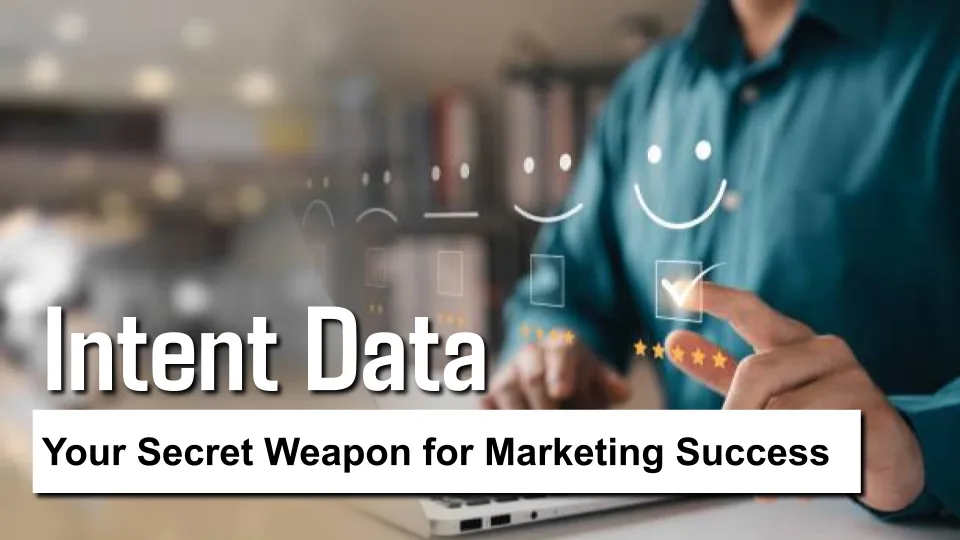Business Insights
Discover AI-powered strategies, business growth tactics, and
marketing insights to scale your business


Intent Data: Your Secret Weapon for Marketing Success
Intent Data: Your Secret Weapon for Marketing Success
Why Understanding Buyer Intent is Key to Dominating Today’s Competitive Landscape
In the digital age, where marketing budgets are under scrutiny and the pressure to demonstrate ROI is greater than ever, the key to a winning strategy lies in understanding your audience's intent. While businesses are already familiar with demographic and behavioral data, intent data is transforming how marketers approach targeting, engagement, and conversion. With the ability to predict purchasing behavior and identify high-value prospects, intent data is no longer a luxury.
It's a necessity.
What is Intent Data and Why Does It Matter?
Intent data is the information that reveals a prospect’s behavior, indicating where they are in their buyer journey and their likelihood to purchase. This data is derived from online activities, such as web searches, content consumption, downloads, or interactions with ads. Unlike traditional data sources, intent data is action-driven, highlighting not just who your audience is but what they are actively looking to solve or achieve.
In marketing today, understanding the “what” and “why” behind a customer’s behavior enables businesses to prioritize leads, craft relevant messages, and time outreach effectively. Research by Forrester indicates that organizations using intent data see a 10-20% improvement in sales pipeline efficiency, underscoring its growing role in B2B and B2C marketing strategies.
How Intent Data Works: The Nuts and Bolts
Intent data operates by tracking digital breadcrumbs left by potential customers across various channels. These signals often come from:
First-Party Data: Information collected directly from your digital properties like your website, email campaigns, or app interactions. This includes pages visited, time spent on site, and downloads.
Third-Party Data: Aggregated insights from external platforms, such as review sites, webinars, or search engines, capturing behaviors outside your owned channels.
For example, when a prospect visits multiple pages on your website focused on a specific service or searches for industry-related solutions on third-party sites, these are clear indicators of intent. Platforms like Bombora, 6sense, and ZoomInfo specialize in analyzing this type of data to help marketers identify high-interest accounts.
The Importance of Intent Data in Personalization
In today’s competitive environment, personalization is not just a bonus; it’s expected. According to Epsilon, 80% of consumers are more likely to do business with a brand that provides a personalized experience. Intent data equips marketers to achieve this by understanding what specific problems prospects are trying to solve and tailoring outreach accordingly.
For instance, if a business notices that a lead has downloaded multiple resources on lead generation strategies, sending a generic email about “marketing best practices” would be a missed opportunity. Instead, a focused message offering an in-depth consultation on advanced lead generation tactics is far more likely to resonate.
Bridging the Gap Between Marketing and Sales
Intent data doesn’t just empower marketing teams; it’s a game-changer for sales as well. One of the biggest challenges in B2B organizations is the alignment between marketing and sales. Sales teams often complain about unqualified leads, while marketing teams struggle to demonstrate the value of their campaigns. Intent data bridges this gap.
With real-time insights into a lead’s interests and readiness to buy, sales teams can focus their efforts on accounts that are actively researching solutions. A 2023 study by Demand Gen Report revealed that 61% of B2B marketers said intent data improved lead quality and conversion rates, proving its value in creating more efficient handoffs between marketing and sales.
Actionable Use Cases for Intent Data
Account-Based Marketing (ABM): Intent data is the backbone of ABM strategies. By identifying accounts showing high intent signals, marketers can prioritize resources on high-value prospects, creating hyper-targeted campaigns that yield better ROI.
Content Strategy: When intent signals highlight trending topics or common pain points, marketers can adjust their content calendar to address these insights. This ensures that blogs, videos, and guides are always relevant to audience needs.
Lead Scoring: By integrating intent data into CRM systems, businesses can enhance their lead scoring models. Leads with higher intent signals can be moved to the top of the pipeline for faster follow-up.
Ad Retargeting: Intent data enables precise retargeting campaigns. If a prospect has visited comparison pages or downloaded competitor guides, they can be retargeted with ads highlighting your unique value proposition.
Challenges in Using Intent Data Effectively
While intent data offers immense potential, it’s not without challenges. One of the primary hurdles is data accuracy and noise. Not every signal indicates genuine intent; some may simply reflect casual browsing or unrelated activity. Companies must ensure they are working with reputable data providers and using AI-powered tools to analyze and filter data meaningfully.
Another challenge is privacy compliance. With regulations like GDPR and CCPA, businesses need to ensure that their use of intent data aligns with legal requirements. Transparency and opt-in strategies are critical to maintaining customer trust.
Key Stats That Highlight Intent Data’s Impact
70% of B2B buyers say they rely more on content and research than ever before to make purchasing decisions (TrustRadius, 2023). Intent data helps brands place relevant content in front of these buyers at the right moment.
Businesses using intent data achieve a 30% higher customer retention rate compared to those relying solely on demographic data (Forrester, 2022).
Intent data adoption in the B2B space is projected to grow by 42% annually, reflecting the increasing demand for actionable insights (MarketsandMarkets, 2023).
The Future of Intent Data in Marketing
The power of intent data is growing as technology advances. AI and machine learning are enabling deeper insights into intent signals, providing predictive capabilities that were once unimaginable. Tools like predictive analytics and natural language processing allow businesses to anticipate customer needs even before they become evident.
Moreover, the integration of intent data with broader data ecosystems—such as CRM, marketing automation platforms, and customer data platforms (CDPs)—is enabling marketers to create seamless, omnichannel experiences. This interconnectedness will soon become the gold standard for brands aiming to stand out in a crowded marketplace.
Why Marketers Can’t Afford to Ignore Intent Data
In today’s fast-moving digital landscape, guessing what your customers want is no longer enough. Intent data provides the actionable insights marketers need to engage prospects effectively, improve ROI, and maintain a competitive edge. As businesses continue to prioritize data-driven decision-making, intent data will remain a cornerstone of successful marketing strategies.
For those willing to embrace its potential, intent data offers more than just improved targeting—it delivers a blueprint for understanding your audience at a deeper level and driving meaningful, measurable growth.

"Holly S#!..."
Mark D.


Innovation
Fresh, creative solutions.

Integrity
Honesty and transparency.

Excellence
High level services.

J.W. CRAWFORD
J.W. CRAWFORD
FOLLOW US
Copyright 2025. J.W. Crawford Management. All Rights Reserved.

Facebook
Instagram
LinkedIn